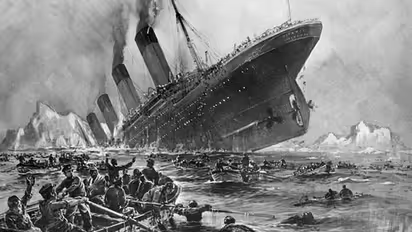Titanic's last hours revealed in most detailed scan yet

Synopsis
A new 3D scan of the Titanic wreck reveals unprecedented details of the 1912 disaster, offering fresh insight into its final hours, from heroic engineers to tiny hull punctures that sealed the ship’s fate.
More than a century after it sank, the RMS Titanic is once again revealing its secrets — this time through a stunningly detailed 3D digital scan.
The full-scale "digital twin" of the wreck, created using over 700,000 high-resolution images and deep-sea robotics, offers the most comprehensive view yet of the iconic ship resting nearly 3,800 meters below the Atlantic, reports BBC.
This remarkable project, undertaken by Atlantic Productions and National Geographic, is the centerpiece of a new documentary Titanic: The Digital Resurrection. The scan is not just a visual marvel — it’s helping historians, engineers, and researchers piece together the ship's final moments like never before.
What the 3D scan shows
The Titanic’s wreck is split into two massive sections. The bow remains eerily intact, still upright as if continuing its voyage. But 600 meters away, the stern lies twisted and crumpled — evidence of the violent force as it plunged to the ocean floor after the ship broke apart.
Among the most revealing discoveries is the detailed view of a boiler room, supporting eye-witness accounts that the ship’s engineers stayed at their posts to keep the lights on, even as the vessel was sinking. Boilers appear warped inward, indicating they were still functioning as water rushed in. An open steam valve on the stern hints that power was being generated until the very last moments — a tribute to the bravery of engineers like Joseph Bell and his team, who all perished.
Also read: UNBELIEVABLE! Gold pocket watch of Titanic's wealthiest passenger sold for $1.2 million
How the ship sank: Simulation offers new answers
In addition to the scan, scientists have created a high-tech simulation using original blueprints and data on Titanic’s speed and position. The findings challenge earlier assumptions. Despite only a glancing blow from the iceberg, the hull suffered multiple punctures — each no larger than an A4 sheet of paper. These small holes, spread across six compartments, ultimately overwhelmed the ship's safety design, which could only withstand flooding in four.
“The difference between Titanic sinking and not sinking came down to tiny ruptures along a long stretch of the hull,” explained naval architect Simon Benson. “The flooding was slow, but inevitable.”
A new way of studying history
Until now, much of Titanic’s wreck could only be glimpsed in fragments through submersible missions. This scan changes everything. It allows experts to study the site like a forensic investigation, placing every object and section of the ship in precise context.
Artifacts such as passenger belongings remain scattered across the sea floor, reminding us of the immense human cost — over 1,500 lives lost.
“This wreck is the last living witness to the disaster,” said Titanic analyst Parks Stephenson. “And it still has stories to tell. Every new scan reveals just a little more.”
Also read: Titanic’s historical dinner menu fetches over Rs 80 lakh at auction!
It may take years for experts to analyze all the data from this scan, but what’s clear is that Titanic continues to fascinate — not just as a shipwreck, but as a powerful symbol of human courage, tragedy, and resilience.
Check the Breaking News Today and Latest News from across India and around the world. Stay updated with the latest World News and global developments from politics to economy and current affairs. Get in-depth coverage of China News, Europe News, Pakistan News, and South Asia News, along with top headlines from the UK and US. Follow expert analysis, international trends, and breaking updates from around the globe. Download the Asianet News Official App from the Android Play Store and iPhone App Store for accurate and timely news updates anytime, anywhere.